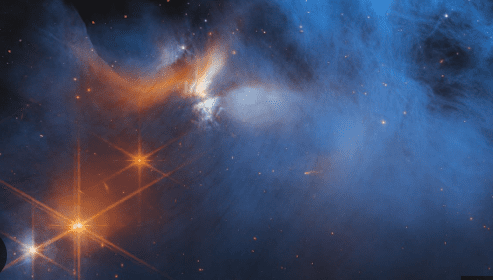The universe is an infinite expanse filled with countless celestial objects. One such mystery that has puzzled astronomers for years is the presence of “phantom galaxies.” Phantom galaxies are an enigmatic phenomenon that has left scientists scratching their heads. These galaxies are essentially invisible to telescopes because they do not emit any light or radiation, making them incredibly difficult to detect. However, recent advancements in gravitational lensing technology have opened up a whole new world of possibilities when it comes to studying phantom galaxies.
What are Phantom Galaxies?
Phantom galaxies, also known as dark galaxies, are a type of galaxy that is mostly made up of dark matter. Dark matter is a type of matter that does not emit, absorb, or reflect any electromagnetic radiation, making it invisible to telescopes. This means that phantom galaxies are incredibly difficult to detect and study.
Phantom galaxies are thought to have formed in the early universe, shortly after the Big Bang. According to current theories, dark matter particles collided and merged together to form dark matter halos. These halos then began to attract gas and dust, which eventually led to the formation of stars and galaxies. However, in the case of phantom galaxies, the gas and dust never coalesced enough to form visible stars and galaxies. As a result, these galaxies remain hidden in the darkness, invisible to telescopes.
The Hunt for Phantom Galaxies
The hunt for phantom galaxies has been a long and arduous one. Traditional telescopes are unable to detect these galaxies because they emit no light or radiation. However, scientists have found a way to indirectly detect phantom galaxies through gravitational lensing.
Gravitational lensing is a phenomenon where the gravitational pull of a massive object, such as a galaxy or a cluster of galaxies, bends the path of light from a more distant object. This bending of light can create a magnifying effect, allowing astronomers to see distant and faint objects that would otherwise be invisible.
By using gravitational lensing, scientists can detect the presence of dark matter halos, which are thought to be associated with phantom galaxies. These halos act as gravitational lenses, bending the light of more distant objects and revealing their presence.
The “Phantom Galaxy NFT”
Recently, a new technology called the “phantom galaxy nft” has been developed, which takes advantage of gravitational lensing to identify phantom galaxies. NFT stands for “non-detection by traditional means,” and it refers to galaxies that are invisible to traditional telescopes.
The phantom galaxy NFT uses the magnifying effect of gravitational lensing to identify regions of space where dark matter halos are likely to be located. By studying these regions, astronomers can detect the presence of phantom galaxies.
The phantom galaxy NFT has the potential to revolutionize our understanding of the universe. By identifying and studying these hidden galaxies, we can learn more about the formation and evolution of galaxies in the early universe.
Implications of Discovering Phantom Galaxies
Discovering phantom galaxies could have significant implications for our understanding of the universe. These galaxies could provide valuable insights into the early universe, shedding light on how galaxies formed and evolved over time. Additionally, the discovery of phantom galaxies could help solve the mystery of dark matter, which is thought to make up around 85% of the matter in the universe.
Studying phantom galaxies could also have practical applications. For example, understanding how dark matter behaves could help scientists develop new technologies, such as more efficient energy storage systems or faster computer processors.
Conclusion
The discovery and study of phantom galaxies is a fascinating area of research that has the potential to change our understanding of the universe. Thanks to advancements in gravitational lensing technology, scientists are now able to identify and study these elusive galaxies, which were once considered impossible to detect. The phantom galaxy NFT is a new tool that uses gravitational lensing to identify regions of space where dark matter halos are likely to be located, allowing astronomers to indirectly detect the presence of phantom galaxies. As we continue to learn more about the universe and its many mysteries, the discovery of phantom galaxies could be a crucial piece of the puzzle. It is an exciting time for astronomy, and the potential for new discoveries and breakthroughs is endless.






























